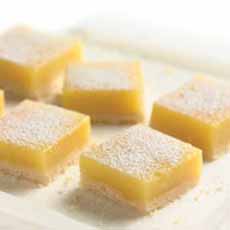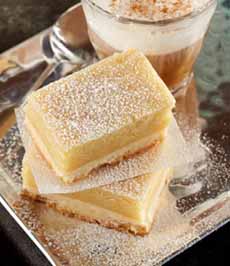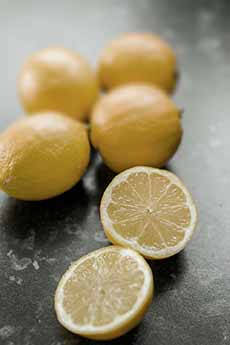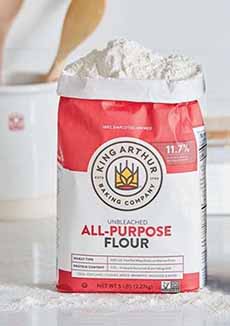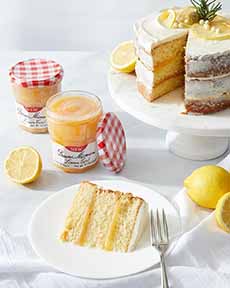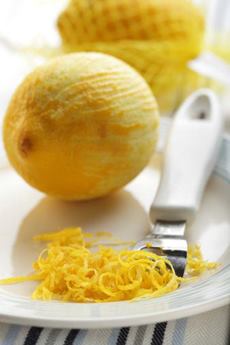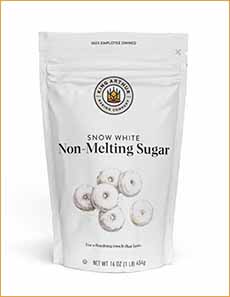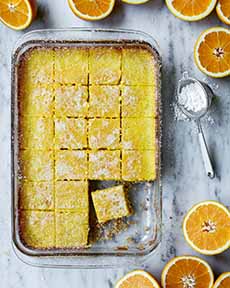Lemon Bars Recipe & History For National Lemon Bar Day
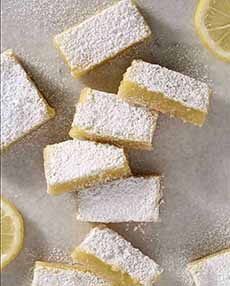 [1] Yummy lemon bars cut into rectangles. The recipe is below (photos #1, #2, #3, and #5 © King Arthur Baking).
|
What’s one to do on National Lemon Bar Day (October 15th)? Bake lemon bars with the recipe below (so easy!). Lemon bars are silky lemon curd* atop a buttery shortbread base, traditionally served dusted with confectioner’s sugar. (Personally, we only add a dab in the center of the bar, because the powdery sugar gets all over the place.) Lemon bars just burst with lemon flavor, and over the years, we’ve realized that we’d rather have a lemon bar than a chocolate brownie. Today’s recipe (below“>below) is courtesy of King Arthur Baking, one of our favorite repositories of delectable recipes. > The history of lemon bars is below. > The 11 different types of cookies. > Lemon glossary: the different types of lemons. > Fruit spreads: the different types from curd to marmalade. > The difference between cookies and bars. > The difference between fruit curd and fruit butter. These classic lemon bars (squares) have a buttery crust, and smooth, rich lemon curd filling. They’re the perfect balance of sweet and tart. Prep time is 10 minutes and bake time is 1 hour. For The Shortbread Crust 2a. MAKE the crust: Whisk together the flour, salt, and confectioner’s sugar. Work in the butter until it’s evenly distributed; the mixture will be crumbly. 2b. PRESS the crust firmly into a parchment-lined 8″ square pan. If the mixture begins to stick to your hands, chill it in the freezer for 5 to 10 minutes, then continue to press it into the pan. It’s important that the crust is firmly anchored to the pan so no filling seeps underneath. 3. BAKE the crust for 30 to 35 minutes, or until it’s golden brown. Remove it from the oven, and reduce the oven temperature to 325°F. While the crust is baking… 4. MAKE the topping: Combine the whole eggs, egg yolk, and sugars and whisk until smooth. Add the flour and salt, then the lemon juice, and whisk until thoroughly combined. 5. LET the filling sit for 15 minutes or so, until the bubbles [mostly] disappear. While the baked crust is still hot, pour the topping over it. Return the bars to the oven and bake until the top layer appears set and relatively dry, about 30 minutes. 6. REMOVE the bars from the oven and cool them completely on a rack before slicing. Just before serving, sprinkle the top of the bars with confectioner’s sugar. Store any leftovers in the refrigerator tightly wrapped, for up to 4 days. Lemon bars, also known as lemon squares (even when they’re cut into rectangles), can be traced back to the 12th century and 19th century, when the lemon curd was created in England curdling fresh cream with lemon juice and straining the whey out from the curds with cheesecloth**. It was also called lemon cheese (up to the 1960s in the U.K.). The earliest printed recipe using this technique appears in 1844 in The Lady’s Own Cookery Book by Lady Charlotte Campbell Bury. The recipe is rather different though because the lemon curd is literally that; lemon acidulating cream to form curds which could then be separated from the whey through some cheesecloth. Shortbread, typically the base of the lemon bar, originated in Scotland in the 12th century and developed its sweet and crumbly form in the 16th century. The first substantial cultivation of lemons in Europe began in Genoa in the mid-15th century. The lemon was subsequently introduced to the Americas in 1493, when Christopher Columbus brought lemon seeds to Hispaniola [source]. The use of lemon as a dessert ingredient dates back to the Renaissance, the tart juice and lemon zest were united with sugar . Even before canning, fruit butter would keep for months if properly sealed and stored). He decided to create National Lemon Bar Day so people would know what a lemon bar is and what it tastes like! n 1492 Christopher Columbus took lemon seeds from Europe to the New world [source]. Both are served in individual portions, but there are two differences: Here, batter or other ingredients are poured or pressed into a rectangular pan (sometimes in multiple layers), then baked and cut into Brownies and lemon bars are examples of bar cookies. In the U.K., bar cookies are known as “tray bakes.” The difference is butter itself. Ironically: |
|
|
________________ *Curd can be made with any acidic fruit: grapefruit, lemon, lime, orange (photo #9), passion fruit, and pineapple, e.g. **The original curd was like a lemon-infused cream cheese. Modern lemon curd has evolved, with the texture of a velvety custard, which dropped the flour and is a luscious combination of butter, sugar, egg yolks, lemon juice, and lemon zest. †Original Lemon Bars Recipe: ‡In the U.S., it is enjoyed as a spread on toast and muffins, used as a pancake topping, or as a filling in cakes, pies, and tarts. ‡‡Confectioner’s sugar comprises granulated sugar ground into a fine powder. But it can melt (disappear) due to hear and moisture from the curd (you can see this happening in photo #9). A better bet is non-melting confectioner’s sugar, which is made with dextrose and fat. It is also less sweet than confectioner’s sugar, which some people will prefer. ‡‡‡Fruit butter has been made since the Middle Ages. CHECK OUT WHAT’S HAPPENING ON OUR HOME PAGE, THENIBBLE.COM. |
||
